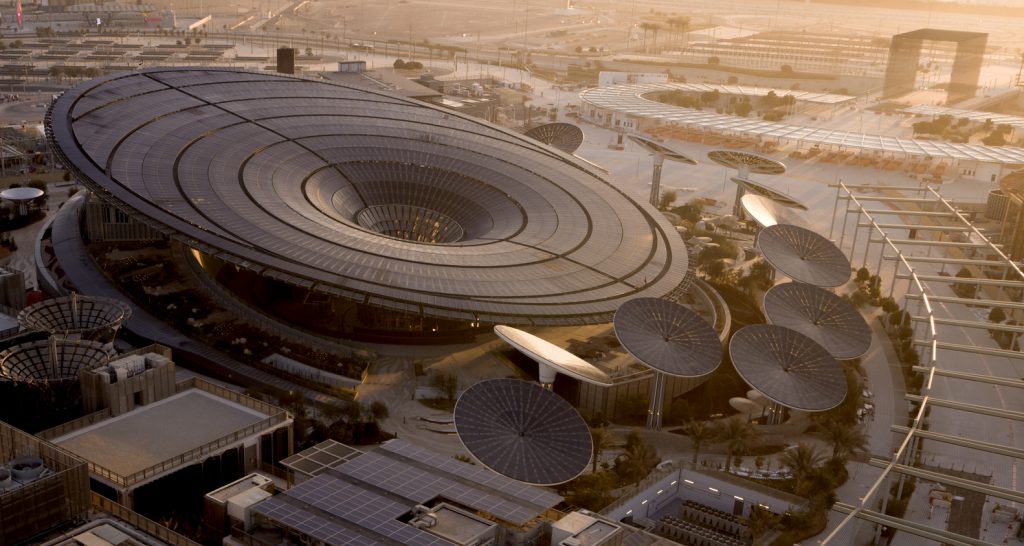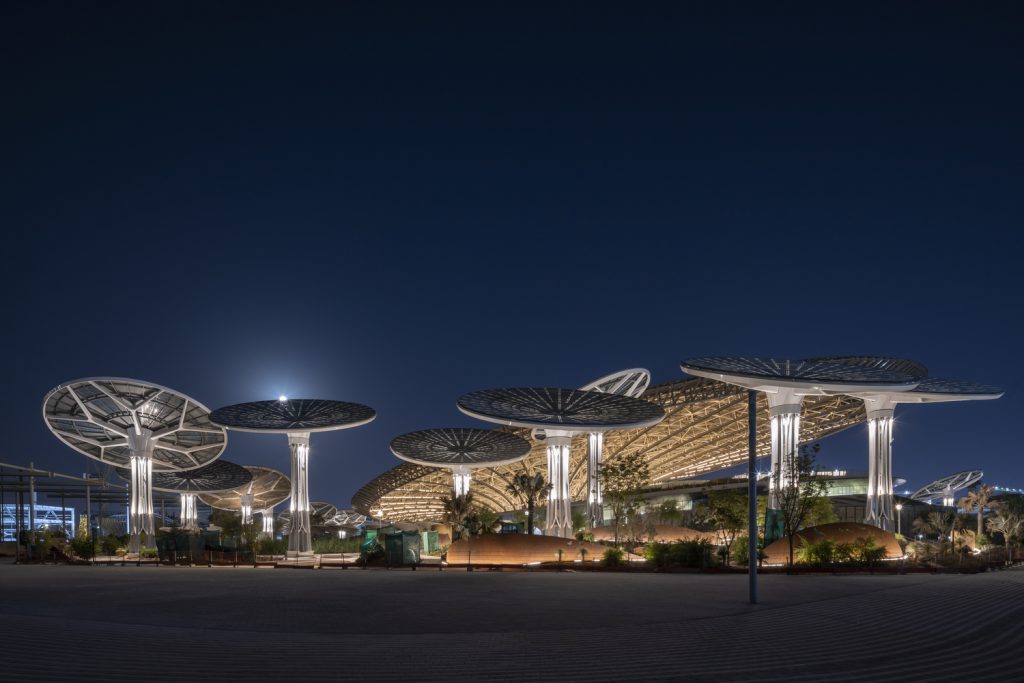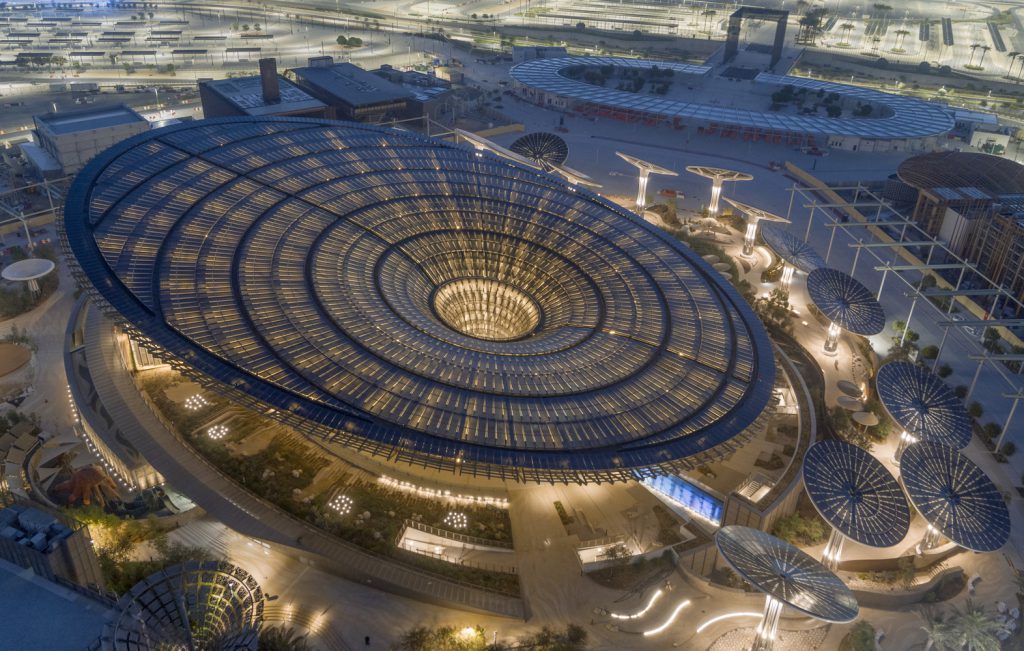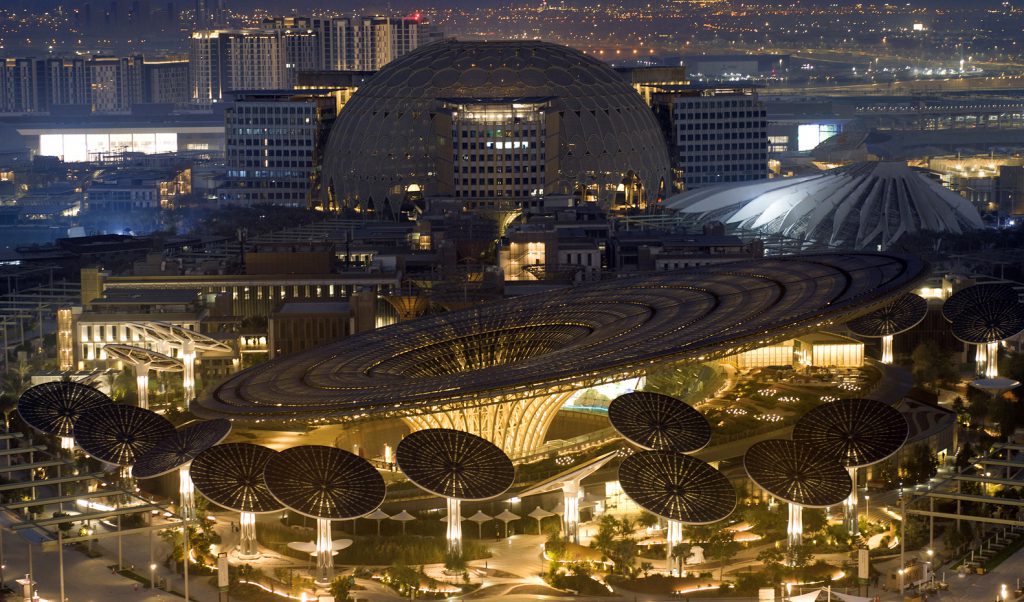The central theme of the Dubai World Expo Connecting Minds, Creating the Future, aims to create opportunities for connectivity and innovation. Under the three major sub-themes: Opportunity, Mobility, and Sustainability, the Expo encourages the exchange of new perspectives and inspires action to offer sustainable solutions for tackling global issues.
Photo Courtesy of Expo 2020 Dubai Expo sustainability pavilion energy trees

งาน World Expo 2020 Dubai ณ กรุงดูไบ สหรัฐอาหรับเอมิเรตส์ มีขึ้นระหว่างวันที่ 1 ตุลาคม 2021 ถึงวันที่ 31 มีนาคม 2022 นับเป็นครั้งแรกของการจัดงานขึ้นในภูมิภาคตะวันออกกลาง โดยมหกรรมครั้งนี้ถูกเลื่อนการจัดมาจากสถานการณ์การแพร่ระบาดของโควิด-19 แนวคิดของธีมหลักในปีนี้ คือ ‘Connecting Minds, Creating the Future’ มีเป้าหมายเพื่อสร้างโอกาสสำหรับการเชื่อมต่อระหว่างกันและนวัตกรรม การกระตุ้นการแลกเปลี่ยนมุมมองใหม่ ๆ และสร้างแรงบันดาลใจในการดำเนินการเพื่อนำเสนอหนทางออกที่ยั่งยืนสำหรับการรับมือกับปัญหาระดับโลก โดยมีประเด็นธีมย่อยสำคัญ 3 หัวข้อ ได้แก่ Opportunity (โอกาส) Mobility (การขับเคลื่อนไปข้างหน้า) และ Sustainability (ความยั่งยืน)
ในส่วนของการออกแบบ งานวางผังบนพื้นที่กว่า 4.38 ตารางกิโลเมตร ถูกแบ่งโซนพื้นที่ออกเป็นสามส่วนตามธีมย่อยของงาน โดยอาคารนิทรรศการหลักๆ ที่น่าสนใจ ได้แก่ อาคารหลักส่วนทางเข้า Sustainability district ขนาดกว่าหกพันตารางเมตร ออกแบบโดยสถาปนิกจากอังกฤษ Grimshaw Architects ที่วางแผนให้อาคารแปลงเป็นพิพิธภัณฑ์ถาวรด้านวิทยาศาสตร์และความยั่งยืนในอนาคตหลังจบงาน ตัวอาคารสร้างขึ้นจากแรงบันดาลใจของต้น Ghaf ที่ทนต่อสภาพแล้ง หลังคาทรงวงรีกว้างกว่า 135 เมตรนี้สร้างด้วยวัสดุเหล็กรีไซเคิล 97% และติดตั้งแผงโซลาเซลล์กว่า 1,055 แผง ซึ่งเป็นกลยุทธ์ของสตูดิโอในการสร้างอาคารที่พึ่งพาตนเองได้ทั้งน้ำและไฟฟ้า โดยรวมกับโครงสร้างต้นไม้พลังงานขนาดเล็กที่หมุนได้สิบแปดต้นที่ล้อมรอบอาคารหลักนั้น คาดว่าจะสามารถผลิตไฟฟ้าได้สี่กิกะวัตต์ชั่วโมงต่อปี ส่วนอาคารหลักในโซน Mobility ออกแบบโดยบริษัทสถาปนิก Foster + Partners ได้รับการออกแบบมาเพื่อให้รู้สึกถึงการเคลื่อนไหว ตัวอาคารโดดเด่นด้วยรูปร่างกลีบดอกไม้ขนาดใหญ่สามกลีบซึ่งค่อยๆ ยื่นออกจากฐานของอาคาร พร้อมการติดตั้งบานเกล็ดระบายอากาศอลูมิเนียมที่โอบรัดรอบตัวอาคารภายนอกช่วยสะท้อนบรรยากาศการเคลื่อนที่โดยรอบ
นอกจากอาคารหลักสองอาคารนี้แล้ว ยังมีอาคารนิทรรศการจากกว่า 180 ประเทศเข้าร่วม รวมทั้งของประเทศไทย ที่แม้จะมีการวิพากษ์วิจารณ์ถึงรูปแบบสถาปัตยกรรมที่ไม่ได้ปรับเปลี่ยนไปจากที่ผ่านมา แต่ยังคงได้รับความนิยมในการเข้าชมเป็นจำนวนมาก อย่างไรก็ดี ผลงานออกแบบสถาปัตยกรรมในงาน World Expo จากสถาปนิกชั้นนำทั่วโลกต่างก็พยายามนำเสนอรูปแบบของนวัตกรรมและความเป็นไปได้ใหม่ๆ ที่หลากหลายในอนาคตมาเสมอตั้งแต่การจัดขึ้นครั้งแรกเมื่อ 170 ปีที่แล้ว และครั้งนี้ก็เป็นอีกครั้งหนึ่งที่ช่วยตอกย้ำถึงศักยภาพของพื้นที่ทางกายภาพและสถาปัตยกรรม ที่จะมีส่วนร่วมกับนวัตกรรมใหม่ๆ ในการสร้างหนทางเพื่อความยั่งยืนและคุณภาพชีวิตที่ดีในอนาคต

World Expo 2020 in Dubai, United Arab Emirates taking place between October 1, 2021, to March 31, 2022 is the first time the event has been held in the Middle East. The event was initially planned to be in 2020 but was postponed due to the epidemic situation of COVID-19. The central theme of the Dubai World Expo Connecting Minds, Creating the Future, aims to create opportunities for connectivity and innovation. Under the three major sub themes: Opportunity, Mobility, and Sustainability, the Expo encourages the exchange of new perspectives and inspires action to offer sustainable solutions for tackling global issues.
On over 4.38 square kilometers, the site is divided into three sections according to the sub-theme of the work. Some of the main buildings of this year’s event include the six thousand square meter Sustainability District, designed by Grimshaw Architects. They also planned the building to be converted into a permanent museum of science and sustainability after the event. Inspired by the drought-tolerant Ghaf tree, the building has a 135-meter-wide oval roof constructed of 97% recycled steel. It is equipped with 1,055 solar panels, which is the studio’s strategy of building a sustainable building with sufficient water and electricity supply. With the eighteen small rotating energy trees surrounding the main building, the building is planned to generate four-gigawatt hours of electricity per year. Another highlight is the main building in the Mobility Zone, designed by Foster + Partners. The building is designed to create a sense of mobility, with the structure characterized by three large flower petals, which gradually protrude from the base of the building, along with the installation of aluminum louvers that wrap around the exterior of the building to reflect the atmosphere of movement around.
There are also exhibition buildings from more than 180 participating countries, including the Thailand Pavilion. Despite the criticism of its traditional architectural style, it is still popular with a large number of visitors. Nevertheless, the architectural designs at the World Expo from leading architects worldwide are more or less an effort to present a form of innovation and new possibilities. It has always been diverse in the future since the first world expo 170 years ago, and this time around, it once again underscores the potential of physical space and architecture – to engage with innovations to create a path for sustainability and a better quality of life in the future.





